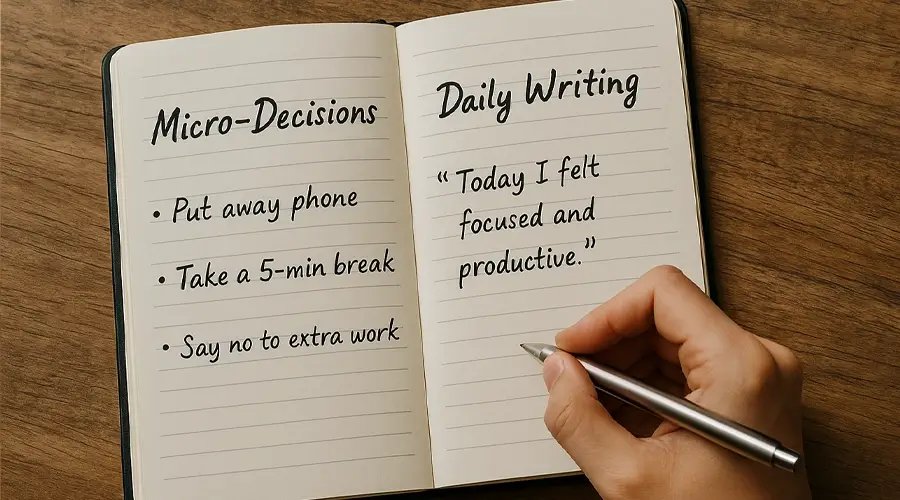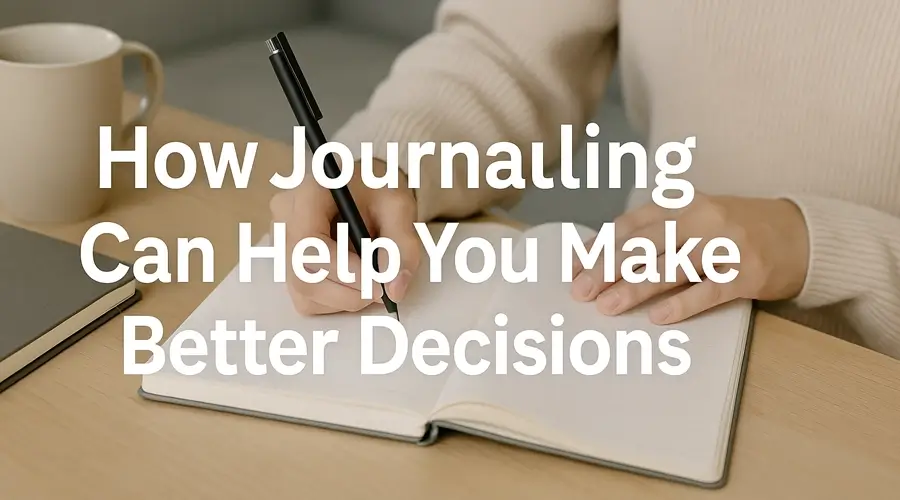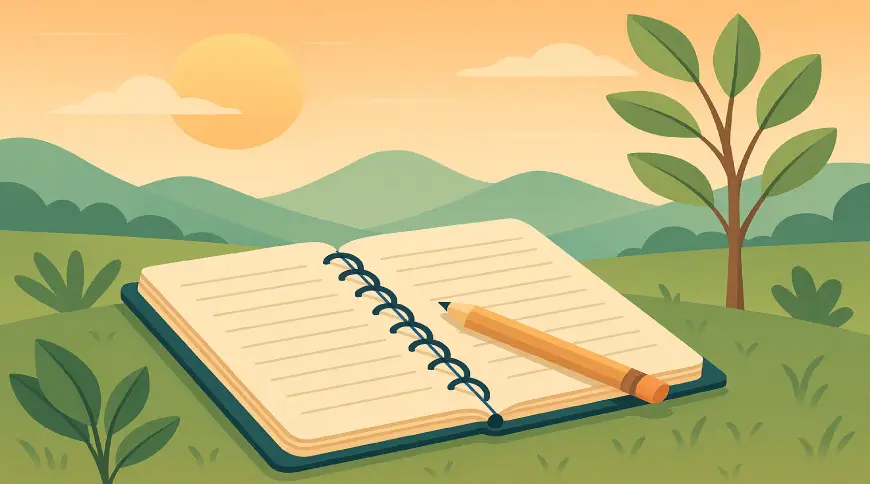Let’s be honest — our brains weren’t built for 10,000 choices a day. Yet here we are, juggling everything from which career path to follow to whether oat milk or almond milk is the right pick this week. Welcome to the age of decision fatigue, where the mental bandwidth needed to make good choices is constantly drained by endless distractions, responsibilities, and the pressure to get it all right.
Modern life is noisy. Social media, email notifications, comparison traps, and tight deadlines all pile up to create what psychologists now call cognitive overload. And when your mind is cluttered, even the simplest decisions feel paralyzing. This is why so many people—especially those in their 20s to 40s—find themselves feeling stuck, reactive, or unsure of what they really want.
Here’s the good news: you don’t need more productivity hacks—you need more clarity. And one surprisingly powerful way to find it? Journaling.
Far beyond “dear diary” stereotypes, journaling has become a trusted tool for entrepreneurs, creatives, therapists, and decision-makers. It allows you to slow down, step back, and reflect—not just on your to-do list, but on your inner thoughts, emotions, and patterns. By putting your thoughts on paper, you create space for intentional decision-making instead of impulsive reactions.
In this article, we’ll explore how a simple journaling practice can help you untangle mental chaos, recognize what matters most, and ultimately—make better decisions.
Mental Clarity Starts with the Page
When your mind feels cluttered, your judgment gets cloudy. You second-guess yourself, postpone decisions, or worse—make choices based on stress, not strategy. That’s where the simple act of journaling becomes a game-changer.
By writing down what’s on your mind, you’re not just dumping thoughts—you’re organizing them. Journaling acts like a mental decluttering tool. It gives you a space to slow down your racing thoughts and see patterns that would otherwise remain buried under noise.
One powerful technique is stream-of-consciousness writing—letting your thoughts flow freely onto the page without censoring or editing. This raw, unfiltered process often reveals what’s truly bothering you, what excites you, or what’s been silently weighing you down. It’s a direct route to the thoughts behind your thoughts.
For example, you might sit down with a cup of coffee and write:
“I’m not sure if I want to take that new job. I keep thinking about the salary, but something feels off. Am I scared of change? Or do I just not trust the people I’d be working with?”
In a matter of lines, you go from surface-level uncertainty to deep introspection. That’s the magic of journaling—it transforms vague anxiety into tangible insight. It gives shape to the mess and turns it into something you can work with.
And you don’t need fancy templates or special prompts to get started. All it takes is a few honest lines a day.
Mental clarity doesn’t arrive all at once. It’s something you build—page by page.
Understanding Emotional Triggers with Reflective Journaling
Sometimes, it’s not the logic of a decision that holds us back—it’s the emotion behind it. Fear of failure, fear of judgment, fear of change… these unspoken feelings shape our actions more than we realize. The problem? Most of us never take the time to explore them. That’s where reflective journaling steps in.
Reflective journaling is the practice of intentionally writing about your thoughts and emotions to uncover deeper insights. Unlike casual journaling, which may simply record what happened during your day, reflective journaling asks:
-
Why did I react that way?
-
What emotion was underneath that decision?
-
What pattern keeps repeating in my life?
By using journaling as a mirror, you start to spot recurring emotional triggers—those invisible drivers that push you toward certain choices and away from others. Maybe you notice that every time you’re criticized at work, you shut down for days. Or that you always say yes to things out of guilt, not desire.
This awareness is the first step to emotional intelligence, a vital ingredient for sound decision-making. When you’re aware of your emotional patterns, you can pause, reflect, and make choices that align with your values—not just your instincts.
You can also try techniques like mood tracking—using a few lines or symbols to map how your emotions fluctuate over time. When paired with reflection, it becomes easier to see which decisions were made in moments of clarity and which were driven by stress or exhaustion.

From Chaos to Clarity: Decision-Making with Prompts and Logs
Sometimes, the hardest part of making a decision is knowing where to begin. When your mind is full of noise—competing priorities, conflicting emotions, and outside opinions—clarity feels impossible. This is where journaling prompts and decision logs can act like a GPS for your brain.
A journaling prompt is simply a question that helps guide your thinking. It acts as a starting point, nudging you toward insight rather than circular overthinking. Try prompts like:
-
What would I choose if I weren’t afraid?
-
What outcome would make me proud, regardless of the result?
-
What have I learned from similar decisions in the past?
These aren’t just feel-good questions—they’re brain openers. They shift you from anxiety loops into clarity mode.
Alongside prompts, creating a decision log—a running list of choices you’ve made, why you made them, and how they turned out—can become a goldmine of self-knowledge. Over time, you’ll begin to spot patterns:
-
Do you make better decisions when you sleep on them?
-
Are you more impulsive when you’re tired or hungry?
-
What do your best decisions have in common?
This kind of self-audit helps you build a personal decision-making playbook—one that’s grounded in experience, not guesswork.
Another tool you can use: the pro/con list—but with a twist. Instead of writing down generic pros and cons, journal through them. Ask:
-
Why is this a “pro” for me personally?
-
Is this “con” based on fear, or on fact?
This method gives weight and depth to what might otherwise be a superficial list. It turns your decision into a dialogue, not just a checklist.
With the right prompts and consistent reflection, journaling becomes more than a writing habit—it becomes a decision-making system tailored to you.

A Real-Life Example: Journaling Through a Big Decision
Let’s bring theory into practice. Meet Sara—29, a UX designer, and someone who recently found herself at a career crossroads. After five years at the same company, she was offered a new role at a trendy startup. It paid more, promised faster growth, and came with all the modern perks. But something didn’t feel quite right.
Instead of rushing into a yes—or avoiding the decision entirely—Sara turned to her journaling practice.
Over the course of two weeks, she wrote about everything: her fears of starting over, excitement about learning something new, the guilt she felt about leaving her current team, and the lifestyle changes that might come with a new position. At first, the pages were messy and emotional. But then patterns started to emerge.
She realized that her hesitation wasn’t about the job itself—it was about losing a sense of identity she had built in her current role. Journaling helped her separate emotional attachment from logical opportunity. She even created a pro/con list, but this time infused with values:
-
Pro: More autonomy
-
Con: Risk of instability
-
Pro: Creative freedom
-
Con: Less mentorship
By the end of the two weeks, her decision felt grounded—not in pressure, not in fear, but in clarity.
Sara turned down the offer—not because she was afraid, but because she realized what she truly valued at this stage of her life: mentorship, team culture, and creative consistency. Six months later, she’s still journaling—and still at peace with that decision.
The point? Your best decisions aren’t always the flashiest ones. They’re the ones that are aligned with your truth. And often, the only way to hear that truth is to write it out.
The Power of Micro-Decisions and Daily Writing
Not every life-changing decision comes with a dramatic fork in the road. In fact, most of the choices that shape your life are small—what you say yes to, what you tolerate, what you delay. These are the micro-decisions that accumulate over time and quietly steer your direction.
The beauty of daily journaling is that it keeps you tuned into these subtle shifts. When you write consistently—even just for 5 minutes—you begin to notice patterns in your thinking, your habits, and your emotional cycles. You become more aware of how small daily choices influence bigger outcomes.
Let’s say you journal about your mood and productivity every evening. After a few weeks, you might realize that your worst days follow late-night scrolling, or that you make better social decisions when you exercise in the morning. These aren’t insights you’d gain from a once-a-month reflection—they come from showing up to the page every day.
Over time, journaling turns into a feedback loop. You make a choice, observe the result, reflect on it, and adjust. That’s how growth happens—not through giant leaps, but through small, intentional steps repeated over time.
And because you’re documenting it, your journal becomes a record of evolution. A mirror of where you’ve been, where you’re headed, and how your decision-making has matured. This continuous loop of awareness and adjustment helps you become not just a better decision-maker, but a more conscious, aligned version of yourself.

How to Start a Decision-Focused Journaling Practice
You don’t need fancy journals, aesthetic pens, or hours of free time to build a journaling habit that sharpens your decision-making. What you do need is intention. A few minutes of honest reflection, done consistently, is far more powerful than pages of scattered thoughts once in a while.
Here’s how to begin your own decision-focused journaling practice:
1. Keep It Simple
Start with just 5–10 minutes a day. You can journal in the morning to set your focus or in the evening to process the day’s choices. Use whatever format feels natural—physical notebook, notes app, or a dedicated digital journaling tool.
2. Use Prompts That Spark Clarity
Instead of writing about “how your day went,” try questions that challenge your mindset:
-
What decision am I avoiding right now? Why?
-
What would the wisest version of me choose today?
-
Am I acting from alignment or fear?
Prompts like these cut through surface-level noise and get to the heart of your process.
3. Don’t Judge, Just Observe
This isn’t a performance. You’re not writing to impress anyone. Let your thoughts flow freely, even if they’re messy or contradictory. Over time, your pages will reveal themes, patterns, and emotional undercurrents that shape your decisions.
4. Revisit and Reflect
Set aside time once a week to read your past entries. What did you learn about yourself? Which choices felt aligned? Which didn’t—and why? This reflection is what transforms journaling from a routine into a growth engine.
5. Make It Yours
Add sketches, lists, bullet points, voice memos—whatever helps you think clearly. The goal isn’t pretty pages; it’s better decisions.
Final Thought: Give Your Choices the Attention They Deserve
In a world that pushes speed and productivity, slowing down to reflect is an act of resistance—and self-respect. Journaling gives your decisions a space to breathe, evolve, and align with who you truly are.
Before you make your next big (or small) decision, try writing it out.
You might be surprised what your own words reveal.
With VERBOAI, your thoughts become patterns—and your patterns become power. Try it now and write your way to better choices.


